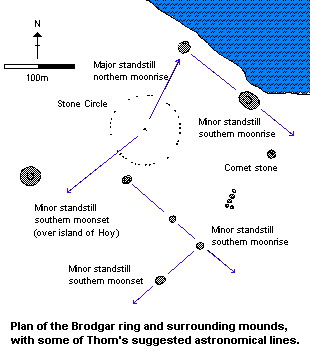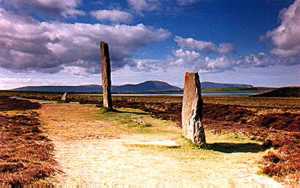
Ring of Brodgar, Orkney
Stones of Wonder
QUICK LINKS ...
HOME PAGE
INTRODUCTION
WATCHING
THE SUN, MOON AND STARS
THE
MONUMENTS
THE
PEOPLE AND THE SKY
BACKGROUND
ARCHAEOASTRONOMY
USING
THE SITE DESCRIPTION PAGES
VISITING
THE SITES
THE
LEY LINE MYSTERY
THE
SITES
ARGYLL
AND ARRAN
MID
AND SOUTH SCOTLAND
NORTH
AND NORTH-EAST SCOTLAND
WESTERN
ISLES AND MULL
Data
DATES
OF EQUINOXES AND SOLSTICES, 1997 to 2030 AD
DATES
OF MIDSUMMER AND MIDWINTER FULL MOONS, 1997 to 2030 AD
POSTSCRIPT
Individual
Site References
Bibliography
Links
to other relevant pages
Contact
me at : rpollock456@gmail.com
Stone Circle, Henge, Mounds HY 29450 13361*
How to find : Follow the A965 west from Kirkwall for 16km, then take the B9055 north-west for 2km. The site is easily visible, and is in state care.
Best time of year to visit : Lunar major and minor standstills (see dates).
 This
attractive and well-visited site consists of a circular ring of stones set inside a bank and deep
ditch cut out of the rock. Such round bank and ditch features are called henges. There are also
several prehistoric mounds nearby. The site is likely to date to the late Neolithic or Early Bronze
age period.
This
attractive and well-visited site consists of a circular ring of stones set inside a bank and deep
ditch cut out of the rock. Such round bank and ditch features are called henges. There are also
several prehistoric mounds nearby. The site is likely to date to the late Neolithic or Early Bronze
age period.
The ring is the biggest stone circle in Scotland, and is fully 103 metres in diameter. The circle was restored in 1906, and many of the fallen stones were re-erected at that time. There are now 27 stones of the ring upstanding, with about 13 stumps still also in position. The tallest stone of the ring is an impressive 4.5 metres tall. Originally, there would have been 60 stones in the circle, spaced at even distances apart. All the surviving stones are carefully set with their flat faces along the perimeter. The external bank and ditch which surrounds the circle is crossed by entrance causeways at the south-east and north-west.
There are carvings on four of the stones, which you may wish to spot. Going clockwise from the north-west entrance, the carvings are on stone 3 (runes, undeciphered), stone 4 (a cross), stone 8 (an anvil), and stone 9 (an ogham inscription). All of these are of a later period than the circle itself.
A. Thom and A.S. Thom have proposed that the ring and surrounding mounds were used together to indicate foresights for observations of the moon at both the major and minor standstills1. A simplified version of the lines suggested are in the diagram above. This interpretation is ingenious, but if mounds were really used astronomically in such a way, this is the only site so far identified where this is true.
One of the suggested astronomical
lines at the Ring of Brodgar is to the minor standstill southern moonset, indicated by the cliffs
at Hellia on the island of Hoy. These cliffs are visible in this photograph of part of the Brodgar
ring and the south-western horizon.

Photo of Brodgar by courtesy of Sigurd Towrie. Find out more about Orkney by visiting his Orkneyjar
Website.